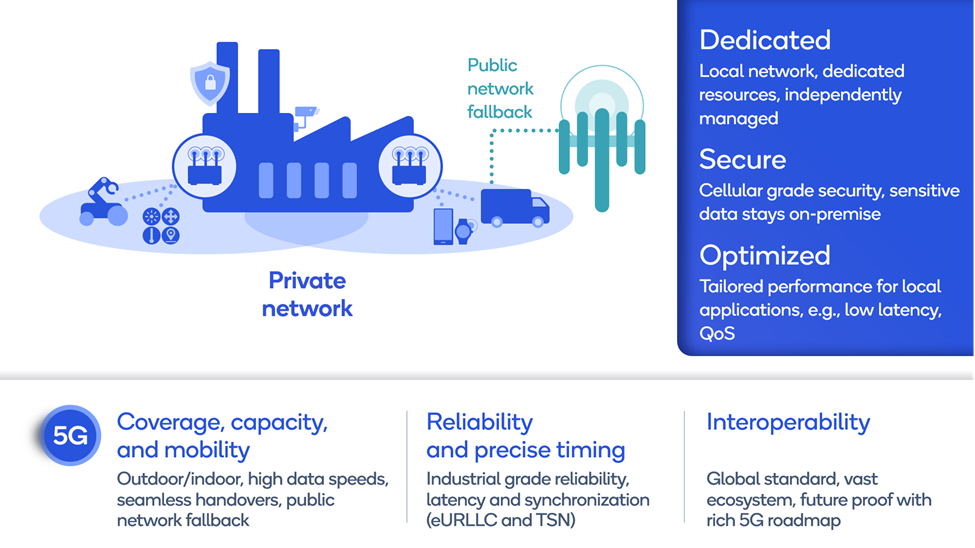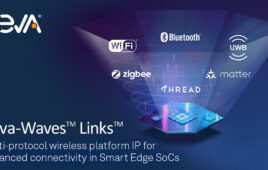As more industries rely on wireless devices, sensors, and artificial intelligence to connect people and machines, private networks bring the potential to enable more advanced IoT applications while increasing security, bandwidth and speed.
While major U.S. telecom operators build their 5G networks, many organizations develop their own networks to take advantage of the next generation of connectivity. Private networks provide complete control of data and critical processes. Typically deployed in one or more specific locations owned or occupied by the end-user organization, private networks reside on premises. Only those devices and users that the organization authorizes obtain network access. Figure 1 highlights what private networks can bring to organizations.

Figure 1. Private 5G networks promise to connect people, sensors, and machines within factories, universities, ports, farms, and other facilities. Source: Qualcomm
Unlike a public network, a private 5G network lets companies define the network’s capability, deployment timetable, and coverage quality. Configurations can vary by site, depending on the type of work undertaken in each venue, and customized to an organization’s specific location and operational needs. Elements include but are not limited to:
Spectrum: Organizations have the option to use either shared spectrum such as the general authorized access (GAA) tier of the Citizens Broadband Radio Service (CBRS) band, local-licensed spectrum dedicated to private networks in some countries, reuse licensed spectrum bands from mobile network operators, or use 5G NR in unlicensed bands as has already been standardized and pending commercialization. The GSMA expects mobile network operators (MNOs) to use spectrum from three principal ranges: (1) Low frequency bands—under 1 GHz (2) Mid frequency bands—in the core 3.3 GHz to 3.8 GHz range (3) High frequency bands known as “millimeter wave” in the 26 GHz, 28 GHz and 40 GHz range.
A rapidly growing number of countries in Asia, Europe and North America have spectrum initiatives underway for private networks. Three examples are:
- Germany allocated 100 MHz in the 3.7 GHz to 3.8 GHz band for local and regional 5G networks that can be used for agriculture, forestry and industrial applications.
- Japan set aside 28.2 GHz to 28.3 GHz for local 5G services and allows private LTE networks to use LTE Band 39 on a shared basis. It’s also considering private 5G allocations in the 4.6 GHz band and between 28.3 GHz to 29.1 GHz.
- The U.S. auctioned 70 MHz between 3.55 GHz and 3.65 GHz.
Core: In addition to spectrum, private 5G wireless networks will require a core, which includes software and hardware that can be acquired from a single or multiple vendor(s) or built with commodity hardware and open-source software. The core is responsible for a range of functions such as traffic shaping and rules for quality of service, billing, data plans, as well as parameters for network monitoring.
Radios and antennas: Private networks need radios and antennas for CBRS spectrum in the US. These Citizens Broadband Radio Devices (CBSDs) need certification from a CBSD test lab.
Identity management: Central to security, the core contains a database of subscribers and manages the subscriber identity module (SIM) cards activated for connection to the private network.
Enterprises can deploy a virtual private mobile network (dedicated network), which typically uses 5G network slicing over the public mobile network. This affords the enterprise some of the advantages of a private network minus the upfront cost and complexity involved in installing and operating an on-site wireless infrastructure (Figure 2).

Figure 2. Private networks can operate standalone or with public networks through network slicing. Source: Qualcomm
Deloitte predicts that hundreds of thousands of companies in sectors such as retail, healthcare, education, utilities, manufacturing and transportation will deploy private 5G networks over the next ten years. While these networks have been taking hold in Europe for some time, the 2020 Federal Communications Commission (FCC) auction finally freed up the necessary spectrum for U.S. enterprises, which can now build their own in house and run it themselves or outsource it to a mobile network operator (MNO) or systems integrator (SI).
In 2020, a wide range of organizations deployed these networks to address specific challenges and explore new opportunities:
- Germany-based Rohde & Schwarz partnered with Nokia to install a private 5G network at its plant in Teisnach, Germany to test new industrial applications and discover how to best optimize 5G for smart factories.
- Ford and Vodafone partnered to develop a private 5G network in the automaker’s new Electrified Powertrain in Manufacturing Engineering (E:PriME) facility located in Essex, England, with a goal to close the connectivity gap in critical automated processes on the factory floor—like welding, which is used extensively for parts that comprise an electric vehicle—and enable secure connectivity across the entire Ford campus.
- British multinational energy and services company Centrica partnered with Vodafone to build the first 5G-ready mobile private network (MPN) for the oil and gas sector at its Easington facility, with a goal to create a digitized ecosystem that enables mission-critical monitoring, control and communications in real time to improve environmental and worker safety among other things.
- The Belgian Port of Zeebrugge partnered with Nokia to deploy an end-to-end private 5G network to track, analyze and manage connected devices across multiple port-based applications in real time and support the use of autonomous vehicles, augmented reality, and drones.
- AT&T and Samsung deployed a 5G testbed at Samsung’s Austin, Texas manufacturing facility, providing a private 5G network that uses millimeter-wave (mmWave) spectrum and leverages LTE and Wi-Fi. The network also uses multi-access edge computing (MEC) to keep data processing close to the end user.
- Lufthansa Technik and Vodafone Business built a standalone private 5G campus network at the Lufthansa base at Hamburg Airport in Germany to give the company the freedom to configure the network according to its needs. For example, technicians can now use high-resolution virtual and augmented reality technologies to work even more precisely and securely on the aircraft 24 fuselages.
According to an independent study from IHS Markit commissioned by Qualcomm, 5G will expand the mobile ecosystem to new industries that will result in $13.1 trillion global economic value by 2035, powering the digital economy, with the support of dedicated private networks, fulfilling targeted needs of organizations in a range of sectors:
- $416B — Precision agriculture
- $984B — Construction and mining
- $264B — Digitized education
- $1,083B — Connected healthcare
- $2,224B — Richer mobile experiences
- $4,771B — Smart manufacturing
- 1,144B — Intelligent retail
- $2,213B — Connected smart cities
Private 5G networks for enterprises bring the potential to exploit new capabilities available in the latest phase of the 5G standard (3GPP Release 16), with enterprises likely to deploy in stages, with an initial focus on seamless mobility. Private 5G networks bring faster and safer operations, new capabilities, and efficiencies in industrial processes. Private networks will also require expertise in network design and management to meet industrial demands on network performance. Industry 4.0 applications have specific demands on communications technology concerning latency, reliability, and security. Thus, we suggest that you begin with test phases that can identify network infrastructure, coverage, and performance issues before a complete rollout.
According to Deloitte, 5G has the potential to become the world’s predominant local area network (LAN) and wide area network (WAN) technology over the next 10 to 20 years, especially in greenfield builds. For industrial users, the ability to design mobile networks to meet the coverage, performance, and security requirements of production-critical applications is fundamental to the new wave of cyber physical systems ushering in Industry 4.0.
Industrial and enterprise operations will benefit from the rich capabilities of 5G, but cutting the data-collection wires, leading to more sensors for greater observability. By adding edge computing, 5G networks will process that data with low latency. Compute-intensive machine learning will efficiently extract valuable insights, thereby reducing the Observe, Orient, Decide, and Act (OODA) loop for industrial processes. Industry 4.0 leaders stand to improve their operational efficiencies, improve their responsiveness to shifts in supply chains or customer demand, and their resilience to disruptive events, all to sharpen their competitive edge and with the power of 5G.
 Marco Contento is the VP of Technologies for Telit. He is a technologist with over 20 years of global wireless experience in IoT technology. He is responsible for Telit’s long-term roadmap of products and leads the 5G program and strategy. Marco has held several titles including Head of Product Management. Marco has been instrumental in working with chipset partners, carriers, key customers, and sales to define product requirements. Marco holds a master’s degree in electronic engineering from University of Trieste.
Marco Contento is the VP of Technologies for Telit. He is a technologist with over 20 years of global wireless experience in IoT technology. He is responsible for Telit’s long-term roadmap of products and leads the 5G program and strategy. Marco has held several titles including Head of Product Management. Marco has been instrumental in working with chipset partners, carriers, key customers, and sales to define product requirements. Marco holds a master’s degree in electronic engineering from University of Trieste.
 Xiaoxia Zhang, Senior Director of Technology, Qualcomm Technologies earned her Ph.D. in electrical engineering from the Ohio State University in 2002, majoring in wireless communications and signal processing. She joined Qualcomm after graduation and has worked on 3G, 4G and 5G, including PHY/MAC system design, evaluation, prototyping and standardization. Dr Zhang is currently leading the project focusing on industrial IOT and shared/unlicensed spectrum on 5G technology.
Xiaoxia Zhang, Senior Director of Technology, Qualcomm Technologies earned her Ph.D. in electrical engineering from the Ohio State University in 2002, majoring in wireless communications and signal processing. She joined Qualcomm after graduation and has worked on 3G, 4G and 5G, including PHY/MAC system design, evaluation, prototyping and standardization. Dr Zhang is currently leading the project focusing on industrial IOT and shared/unlicensed spectrum on 5G technology.





Have you tried to design a private network? What’s your experience?